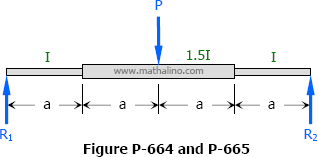The deflection δ at some point B of a simply supported beam can be obtained by the following steps:

1. Compute  = ZCA
= ZCA
 = ZCA
= ZCA
2. Compute  = ZBA
= ZBA
 = ZBA
= ZBA
3. Slope at support A = O A = t CA /L = ZCA / L
4. Slope at support C = O C = tCA/ L = ZCA / L
5. Solve δ by ratio and proportion (see figure above).

Problem:1
The middle half of the beam shown in Fig. has a moment of inertia 1.5 times that of the rest of the beam. Find the midspan deflection.
(Hint: Convert the M diagram into an M/EI diagram.)

Solution :





Therefore,
 → answer
→ answer
 → answer
→ answerProblem : 2
Determine the value of EIδ at the right end of the overhanging beam shown in Fig.

Solution :


















 → answer
→ answer
Comments
Post a Comment